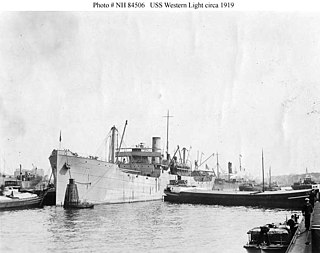
The first USS Nantahala (ID-3519) was a United States Navy cargo ship in commission from 1918 to 1919.

USS Zaca (ID-3792) was a steel-hulled, single-screw freighter that served in the United States Navy from 1918 to 1919. She was the first ship to serve by that name.

MS West Grama, sometimes spelled as West Gramma, was a diesel-powered cargo ship of the United States Maritime Commission (USMC) that was sunk as part of the "gooseberry" breakwater off Utah Beach during the Normandy invasion. Prior to her diesel conversion, she was known as SS West Grama. In 1919, she was briefly taken up by the United States Navy under the name USS West Grama (ID-3794).

The second USS Wachusett (ID-1840) was a cargo ship that served in the United States Navy from 1918 to 1919.

Wakulla was a steam cargo ship built in 1918-1919 by Los Angeles Shipbuilding & Dry Dock Company of San Pedro for the United States Shipping Board as part of the wartime shipbuilding program of the Emergency Fleet Corporation (EFC) to restore the nation's Merchant Marine.
USS Watonwan (ID-4296) was a United States Navy cargo ship in commission in 1919.

USS Alaskan (ID-4542) was a United States Navy cargo ship and troop transport in commission from 1918 to 1919.

USS Arizonan (ID-4542A), also written ID-4542-A was a United States Navy cargo ship and troop transport in commission from 1918 to 1919.
USS West Gambo (ID-3220) was a steel-hulled, single-screw cargo ship that served in the United States Navy from 1918 to 1919. She later saw commercial service as SS West Gambo and SS Empire Hartebeeste, and under the latter name was sunk during World War II.

USS West Elcasco (ID-3661) was a steel-hulled cargo ship which saw service as an auxiliary with the U.S. Navy in World War I and as an Army transport in World War II.

USS West Zula (ID-3501) was a United States Navy cargo ship in commission from 1918 to 1919.

USS Willimantic (ID-3549) was a cargo steamship. She was built in 1918 and served in United States Navy commission from 1918 to 1919. She was transferred to United Kingdom Ministry of War Transport service in 1942 and sunk by enemy action in June of that year.
USS West Mead (ID-3548), also spelled Westmead, was a United States Navy cargo ship in commission from 1918 to 1919.
USS Western Belle (ID-3551) was a United States Navy cargo ship in commission from 1918 to 1919.
USS Bellingham (ID-3552) was a United States Navy cargo ship in commission from 1918 to 1919. She later served the government of the Soviet Union as SS Nevastroi for many years.

USS Berwyn (ID-3565) was a United States Navy cargo ship in commission from 1918 to 1919. She saw service in the final weeks of World War I, then entered commercial service in 1919 as SS Berwyn. She was wrecked in 1920.
USS Western Comet (ID-3569) was a United States Navy cargo ship in commission from 1918 to 1919.

USS Westpool (ID-3675) – sometimes written as West Pool – was a cargo ship of the United States Navy that served during World War I and its immediate aftermath. As SS Westpool, she was sunk during World War II after being sold to the United Kingdom for use as a merchant ship.

USS Western Light (ID-3300) was a cargo ship of the United States Navy that served during World War I and its immediate aftermath.`

USS Western Chief (ID-3161) was a cargo ship of the United States Navy that served during World War I and its immediate aftermath. As SS Western Chief, she was sunk during World War II after being sold to the United Kingdom for use as a merchant ship.














